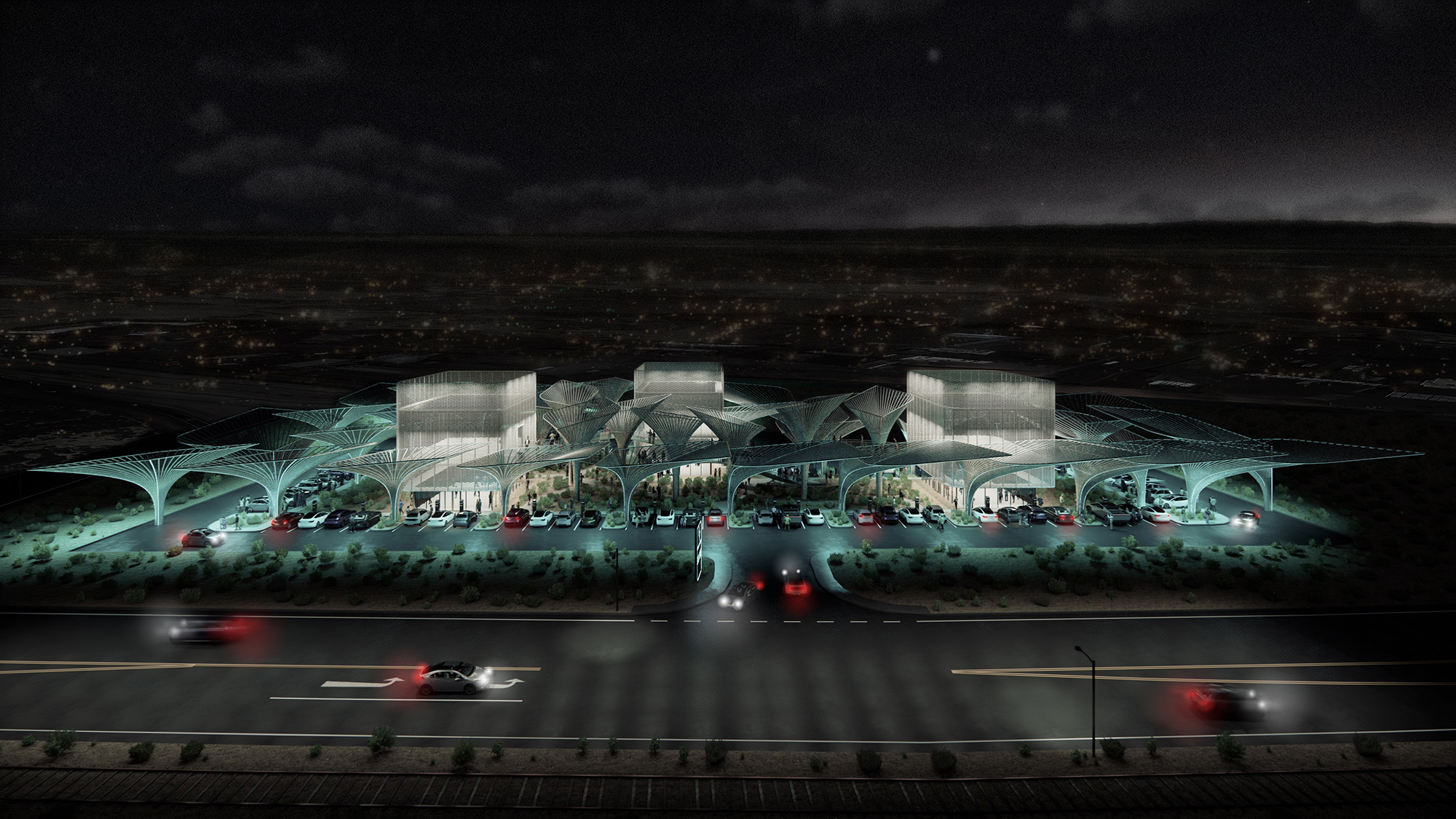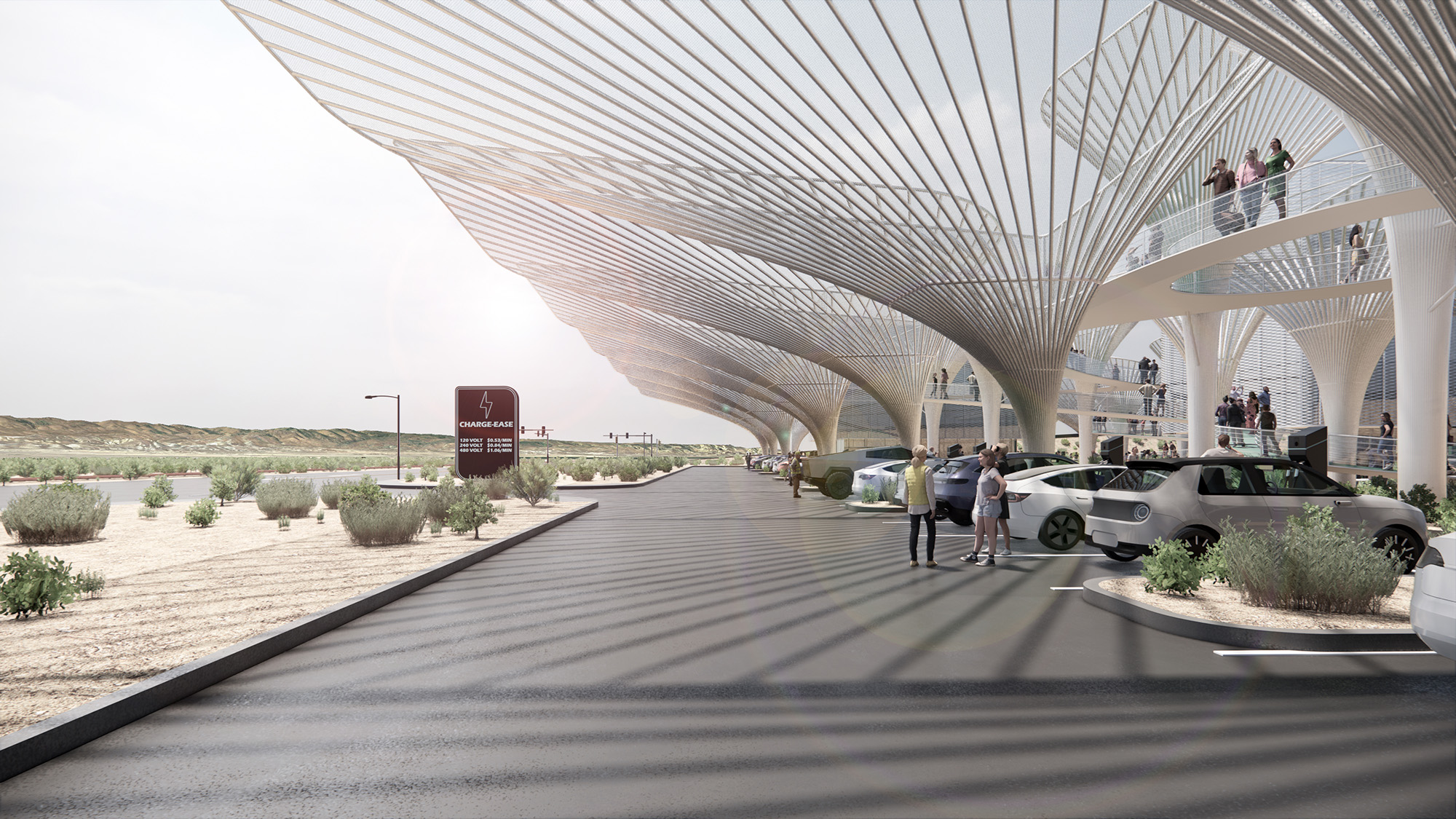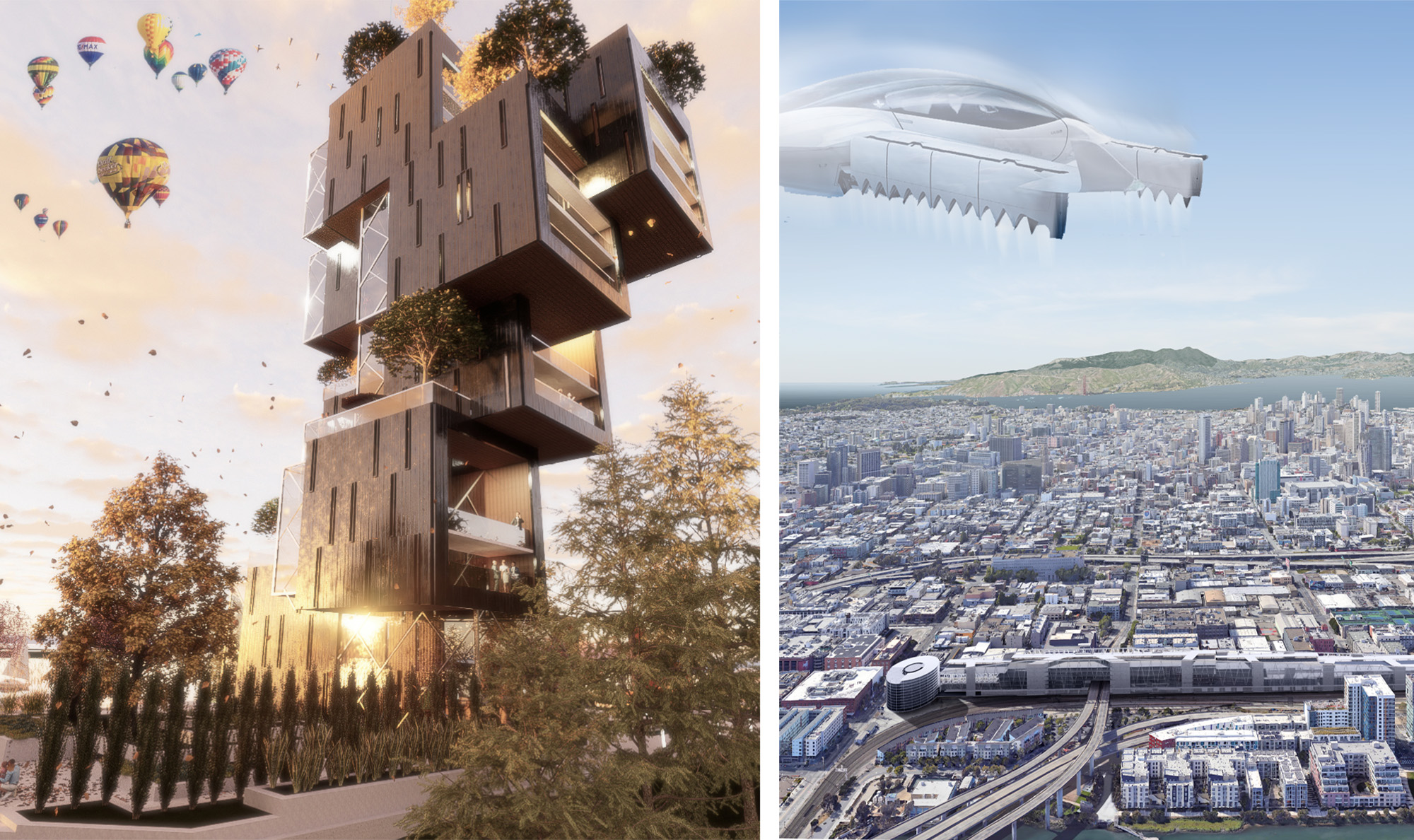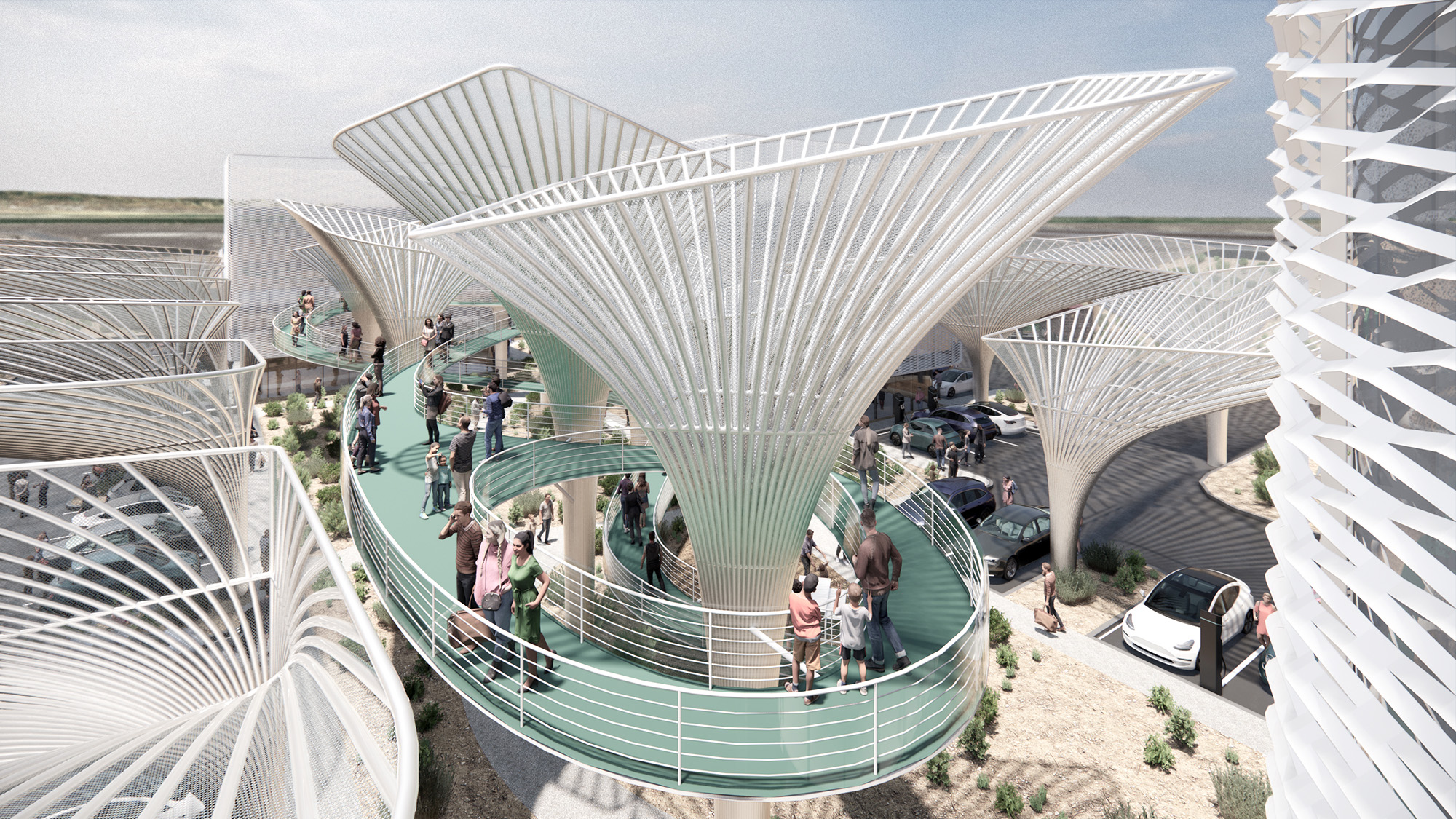A concept that would use structural steel to reinvent the gas station experience for the EV age has won the American Institute of Steel Construction’s 2023 Forge Prize. LVL (Level) Studio collaborators Jeffrey Lee, Christopher Taurasi, and Lexi White won the $10,000 grand prize in a YouTube live stream Thursday afternoon. They worked with Schuff Steel Senior Vice President Christian Crosby to refine their Electric Oasis vision and make the process of bringing it to life in steel more efficient.
The project team will give an encore presentation at Architecture in Steel at NASCC: The Steel Conference in Charlotte, N.C. at 11:30 a.m. on Wednesday, April 12.
The judges were particularly impressed by the team’s thoughtful approach, which turns a banal task into a destination event.
Electric Vehicle Landscape Reshaping Our 'Gas' Stations
“You’ve taken something very mundane that we give not a second thought to usually and injected a certain level of magic—not just waiting for the charging, but also what you can do with that time,” said Forge Prize Judge Melanie Harris, AIA, LSSYB, NCARB, who is the national healing practice director at BSA LifeStructures. “We’re all looking for efficiencies in our life these days and the last thing we want to do is wait around and do nothing while we wait for our cars to charge.”

The time it takes to recharge is, the team noted, one of the primary differences between a gas and electric vehicle.
“On average, a gas stop takes around seven minutes to refill a tank,” Lee said. “A level-two charging station, which is the most common type, takes upwards of four and a half hours for a full charge. We have an opportunity to reimagine the gas station typology into something that can revitalize the local economy.”
So what to do with that time? In their vision, motorists would relax, work, play, shop, or perhaps even get healthcare while their vehicles charge—all activities that offer new economic opportunities for small communities around highway interchanges. These charging stations are defined by striking steel canopies that offer shade. In their primary use case, for a site within average EV range of both Los Angeles and San Francisco, a pathway winds through the canopies, offering vistas and an engaging space in a loop that takes about 15 minutes to explore.
The pathway connects buildings that would house retail and other spaces—with photovoltaic panels on the roof, naturally. Those hubs feature a steel scrim that is both beautiful and functional, providing shade that would reduce solar gain by up to three hours a day.
The design takes advantage of steel’s unique modular potential to facilitate economical, rapid erection—and steel’s unique recyclability and circular supply chain add an additional layer of sustainability while reinventing the existing infrastructure.

“This is a vehicular kind of society,” noted Forge Prize Judge Rona Rothenberg, FAIA, DBIA, the 2022 president of AIA California, noting that it’s applicable to a vast number of sites across the country. “This is a great way to reuse what we already have and transform it into a resilient, sustainable, and lasting solution.”
What motorists may not see while they’re enjoying the amenities: soil remediation. The design includes a mechanism to clean up any ground contamination left over from the site’s use as a gas station.
Forge Prize 2023 Finalists
LVL (Level) Studio was one of three finalists in the competition.
First runners-up Junior Carbajal and Masamichi Ikeda (both of JRMA Architects Engineers) won praise for their Adaptive Micro Cities design, which would create a self-sustaining virtual community with separate zones where people can live, work, and play all brought together with a series of modular boxes, to revitalize a small island in a Portland, Ore., industrial zone.
The judges were also impressed by the scale of second runner-up Then Le’s (Huntsman Architectural Group) Trans-connect multi-modal transportation hub and its thoughtful plan for everything from high-speed trains to electric airplanes in San Francisco.

The American Institute of Steel Construction’s annual Forge Prize competition celebrates emerging architects who create visionary designs that embrace steel as the primary structural component while exploring ways to increase project speed.
AISC would like to thank Melanie Harris, Sean Joyner (writer & communications strategist at Perkins & Will), and Rona G. Rothenberg for serving as this year’s Forge Prize judges. High-res photos of all three projects are available here.
About the American Institute of Steel Construction
The American Institute of Steel Construction, headquartered in Chicago, is a non-partisan, not-for-profit technical institute and trade association established in 1921 to serve the structural steel design community and construction industry. AISC's mission is to make structural steel the material of choice by being the leader in structural steel-related technical and market-building activities, including specification and code development, research, education, technical assistance, quality certification, standardization, market development, and advocacy. AISC has a long tradition of service to the steel construction industry of providing timely and reliable information.
Related Stories
Building Technology | Aug 23, 2024
Top-down construction: Streamlining the building process | BD+C
Learn why top-down construction is becoming popular again for urban projects and how it can benefit your construction process in this comprehensive blog.
Products and Materials | Aug 8, 2024
EPA issues $160 million in grants for clean manufacturing of steel, other construction materials
The U.S. Environmental Protection Agency will provide 38 grant recipients with nearly $160 million to support efforts to report and reduce climate pollution from the manufacturing of construction materials and products.
Mass Timber | May 22, 2024
3 mass timber architecture innovations
As mass timber construction evolves from the first decade of projects, we're finding an increasing variety of mass timber solutions. Here are three primary examples.
ProConnect Events | Apr 23, 2024
5 more ProConnect events scheduled for 2024, including all-new 'AEC Giants'
SGC Horizon present 7 ProConnect events in 2024.
75 Top Building Products | Apr 22, 2024
Enter today! BD+C's 75 Top Building Products for 2024
BD+C editors are now accepting submissions for the annual 75 Top Building Products awards. The winners will be featured in the November/December 2024 issue of Building Design+Construction.
BIM and Information Technology | Mar 11, 2024
BIM at LOD400: Why Level of Development 400 matters for design and virtual construction
As construction projects grow more complex, producing a building information model at Level of Development 400 (LOD400) can accelerate schedules, increase savings, and reduce risk, writes Stephen E. Blumenbaum, PE, SE, Walter P Moore's Director of Construction Engineering.
Codes and Standards | Feb 20, 2024
AISC, AIA release second part of design assist guidelines for the structural steel industry
The American Institute of Steel Construction and AIA Contract Documents have released the second part of a document intended to provide guidance for three common collaboration strategies.
Modular Building | Feb 6, 2024
Modular fire station allows for possible future reconfigurations
A fire station in Southern California leveraged prefab, modular construction for faster completion and future reconfiguration.
75 Top Building Products | Dec 13, 2023
75 top building products for 2023
From a bladeless rooftop wind energy system, to a troffer light fixture with built-in continuous visible light disinfection, innovation is plentiful in Building Design+Construction's annual 75 Top Products report.
Engineers | Oct 12, 2023
Building science: Considering steel sheet piles for semi-permanent or permanent subsurface water control for below-grade building spaces
For projects that do not include moisture-sensitive below-grade spaces, project teams sometimes rely on sheet piles alone for reduction of subsurface water. Experts from Simpson Gumpertz & Heger explore this sheet pile “water management wall” approach.

















